We've moved this content over from an older government website. We'll align this page with the ontario.ca style guide in future updates.
Classification of work
What does the classification of work determine?
The classification of the work determines what other provisions of the Regulation apply to an operation; for example, notification requirements (section 11), measures and procedures (sections 14, 15, 16, 17, and 18), medical surveillance (section 22), record keeping (sections 21 and 22), and training and certification requirements for workers involved Type 3 operations (section 20). As the classification of the work goes from Type 1 to Type 3, the corresponding requirements of the Regulation become increasingly more stringent. The Regulation does not specify who is to do the classification, but, in most cases, it will be the constructor or employer, often in consultation with an appropriately qualified consultant.
What is the difference between the classifications of work?
The three classifications of operations (Type 1, Type 2 and Type 3) have been established according to the asbestos hazard presented by the work, both to those doing the work and to others outside the work area. They can be thought of as being associated with a low, medium, and high risk of exposure. Activities have been assigned to one of the three types of operations based on an assessment of the risk of exposure. Factors that affect worker exposure to asbestos include the type of asbestos, the type of binder or matrix, the type of work, and the type of control measures used.
What operations fall within Type 1 Operation?
Type 1 operations present the lowest exposure risk, generally including the installation or removal of ACM products that are non-friable, that is, material that is not easily crumbled between the thumb and the fingers, or is not already crumbled. The work must be done without damaging the material, or where the material will be damaged, the spread of fibres must be controlled by wetting the material and using non-powered handheld tools. Type 1 operations include:
- installation or removal of ACM ceiling tiles (less than 7.5 m2) without damage (damage includes breakage, cutting, abrading, grounding, sanding, and vibration)
- installation or removal of non-friable ACM, other than ceiling tiles, without damage
- breaking, cutting, drilling, abrading, grinding, sanding or vibrating non-friable ACM that is wetted and where the work is done using non-powered hand-held tools, and
- removal of less than one square metre of drywall where ACM joint-filling compounds were used
Examples of Type 1 Operations
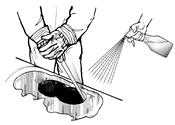
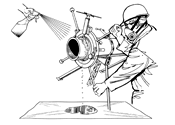
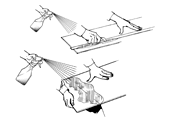
Source: Construction Safety Association of Ontario
What operations fall within Type 2 Operation?
The following types of operations are classified as Type 2 operations:
- the removal of all or part of a false ceiling to access a work area, if ACM is likely to be lying on the surface of the false ceiling
- enclosure of friable ACM
- application of tape, a sealant or other covering to pipe or boiler insulation that is ACM
- installing or removing ACM ceiling tiles that cover an area of 7.5 m2 or more if the work is done without damaging the tiles
- breaking, cutting, drilling, abrading, grinding, sanding, or vibrating non-friable ACM using non-powered hand-held tools if the material is not wetted
- cleaning or removing filters used in air handling equipment in a building that has sprayed ACM fireproofing
- removal or disturbance of one square metre or less of friable ACM during the repair, alteration, maintenance or demolition of all or part of machinery or equipment or a building, aircraft, locomotive, railway car, and
- glove bag removals of ACM insulation
Work that may expose a worker to asbestos and that is not classified as a Type 1 or Type 3 operation, is also to be classified as a Type 2 operation.
Example of Type 2 Operation
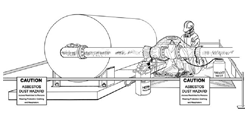
Source: Construction Safety Association of Ontario
What operations fall within Type 3 Operation?
Work with friable or non-friable ACM that has the potential to generate high concentrations of asbestos fibres in air is classified as Type 3. Type 3 operations include:
- removal or disturbance of more than one square metre of friable ACM
- spray application of a sealant to friable ACM
- cleaning or removal of air-handling equipment, including rigid ducting but not including filters, in a building that has sprayed ACM fireproofing
- repair, alteration or demolition of a kiln or furnace made, in part, of refractory materials that are ACM
- breaking, cutting, drilling, abrading, grinding, sanding or vibrating non-friable ACM with power tools not attached to dust-collecting devices with HEPA filters, and
- repair, alteration or demolition of a building in which asbestos products were manufactured, unless the asbestos was cleaned up and removed before March 16, 1986
Example of Type 3 Operation
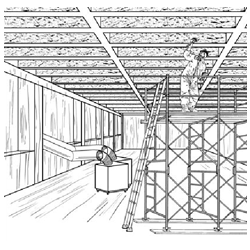
Source: Construction Safety Association of Ontario
What kinds of problems occur in classifying asbestos work?
Problems in classifying asbestos work may arise either because the Regulation does not say how a particular job is to be classified or because there is a dispute regarding the classification of the work. Any work with asbestos that is not mentioned in the Regulation as Type 1 or Type 3 is to be classified as Type 2 (see paragraph 11 of subsection 12(3)). Subsection 12(6) says that disputes regarding the classification of the work can be referred to a Ministry of Labour, Training and Skills Development inspector, nearest the workplace of the dispute, by anyone involved in the dispute. The inspector will investigate and provide a written decision. Work on the operation must cease until the inspector has given a decision in writing.
The referral of a dispute to a Ministry inspector does not affect an inspector's power to issue an order for a contravention of the Regulation.
How is work on plaster stucco and other hard finishes that are ACM but not explicitly mentioned in the Regulation classified?
It is the Ministry's position that wetting does not adequately control the spread of dust and fibres during the breaking, cutting, drilling, abrading, grinding, sanding or vibrating of asbestos-containing plaster, stucco and other hard finishes by means of non-powered hand-held tools. As such, Type 1 procedures cannot be used for work on these materials. The work will likely be classified as a Type 2 (subsection 12(3), paragraph 6, subsection 12(3) paragraph 8) or Type 3 (subsection 12(4) paragraph 5) operation depending on the tools used.